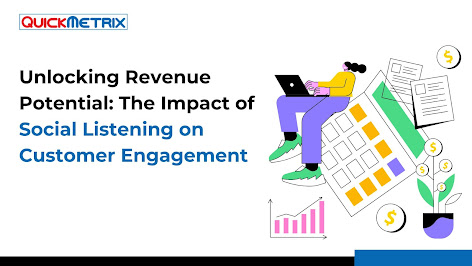Unlocking Revenue Potential: The Impact of Social Listening on Customer Engagement
Unlocking Revenue Potential: The Impact of Social Listening on Customer Engagement
It's crucial to distinguish between social listening and social monitoring. While social monitoring involves tracking mentions of your brand or relevant keywords, social listening goes deeper, focusing on the context, emotions, and discussions surrounding those mentions. This shift allows brands to engage in meaningful conversations based on genuine customer feedback.
Social listening plays a vital role across various industries, from retail to tech to healthcare. Brands can identify untapped opportunities and strengthen connections with their audience by staying informed about customer perceptions and industry shifts.
Tracking social conversations is essential for several reasons:
Identifying customer needs and pain points: By listening to what customers express online, brands can uncover specific challenges they're facing and create solutions that address these issues.
Recognizing trends and patterns in consumer behavior: Social listening helps businesses spot emerging trends and shifts in consumer preferences, allowing them to adapt their strategies accordingly.
Assessing brand perception through social feedback: By gauging how customers talk about the brand, companies can understand their reputation and make informed decisions to improve their image.
There are numerous social listening tools available to help brands track social conversations effectively. Popular options include:
QuickMetrix: A user-friendly platform for monitoring, social listening, and orm and analyzing social media activity.
Brandwatch: Offers in-depth analytics and sentiment analysis, making it easier to understand customer emotions.
Sprout Social: Combines social listening with scheduling, reporting, and engagement tools.
To collect and analyze social data, brands can leverage various methods such as surveys, polls, and direct customer interactions. Integrating social listening insights with other data sources, like CRM data and website analytics, can provide a more comprehensive view of customer behavior and preferences.
Personalized communication can significantly enhance customer engagement. Brands that tailor their messages show they understand their audience, fostering deeper connections. Beyond just responding, brands can develop community engagement by hosting Q&A sessions, polls, or discussions on social platforms, allowing customers to feel more involved.
Effective response strategies to customer queries, such as timely and thoughtful replies, can turn a negative experience into a positive one, showcasing that the brand genuinely cares about its customers.
Using insights gathered from social listening, brands can create targeted content that resonates with their audience. This involves:
Tailoring content to match audience interests: By understanding what customers are talking about, brands can produce blog posts, videos, and social media content that aligns with current conversations.
Leveraging customer feedback to improve content relevance: Businesses can take note of popular topics and themes that emerge from discussions and adapt their messaging to better suit the audience's preferences.
Utilizing stories and testimonials for enhanced connection: Incorporating customer stories can build an emotional connection, as potential customers see relatable experiences that validate their choices.
Social feedback provides valuable insights into customer sentiment, helping brands gauge how they are perceived. Monitoring tools can alert companies to changes in sentiment, enabling them to address potential crises or negative trends early.
Implementing effective strategies for reputation management involves engaging with customers quickly and authentically, demonstrating that the brand values their input and experiences.
The journey from engagement to conversion often starts with social listening. Observing patterns in customer behavior can reveal what prompts purchasing decisions.
There are numerous case studies showcasing successful customer conversions initiated through social media interactions. Brands that effectively respond to inquiries or provide valuable content often see increased sales as a result.
Best practices for closing sales through social channels include direct and honest communication, personalized offers, and responding promptly to customer inquiries.
The link between engagement and loyalty is significant. Brands that consistently engage with their customers are likely to foster a loyal customer base. Strategies for maintaining ongoing customer relationships include personalized follow-ups, exclusive offers for loyal customers, and regular check-ins to ensure satisfaction.
Utilizing data-driven insights helps brands improve customer experiences, enhancing satisfaction and, ultimately, retention.
Key performance indicators (KPIs) that reflect the effectiveness of social listening efforts include engagement rates, conversion rates, and customer feedback. Brands can analyze the return on investment (ROI) of their engagement strategies by tracking how social interactions correlate with sales growth.
Tools for tracking revenue influenced by social engagement involve integrating social media metrics with sales data, enabling companies to see how social efforts lead to revenue.
In an age of heightened data privacy awareness, guidelines for ethical data collection are crucial. Brands must navigate regulations such as GDPR while ensuring they respect customer privacy. Building trust with customers regarding how their data is used fosters a positive brand image.
With vast amounts of data generated daily, brands face challenges prioritizing insights effectively. Developing a strategy for effective data prioritization and utilizing automation tools can alleviate the burden, allowing brands to focus on quality rather than quantity.
A collaborative environment is essential for successful social listening. Breaking down silos between marketing, sales, and customer service ensures that everyone is aligned and informed about customer insights. Fostering a culture of shared insights encourages integrated communication across teams, leading to more informed decision-making.
As technology continues to advance, new tools with enhanced capabilities are emerging. The integration of artificial intelligence in social listening allows brands to analyze vast amounts of data efficiently. Predictive analytics can help anticipate future consumer behavior, making it easier to adapt to trends.
Today's consumers crave genuine brand interactions. Strategies to promote authenticity through engagement include sharing behind-the-scenes content, employee stories, and real customer testimonials. The impact of authentic communication on brand loyalty can be profound, as customers appreciate transparency.
With shifts in social media usage patterns, brands must remain agile. Adapting engagement strategies to align with changing norms means staying informed about how audiences prefer to interact online. Anticipating future trends based on listening insights can position brands ahead of the curve.
The relationship between social listening and customer engagement is clear: effective social listening can unlock significant revenue potential while building lasting connections with customers. Brands embracing this practice can better understand and respond to their audience, ultimately fostering loyalty and driving growth.
"Investing in social listening is investing in your relationship with customers."
What is the difference between social listening and social monitoring?
Social listening focuses on understanding the context and emotions behind conversations, while social monitoring tracks specific mentions or keywords.
How can small businesses benefit from social listening?
Small businesses can use social listening to identify customer needs, engage effectively, and tailor their marketing strategies, helping them compete with larger brands.
What are some effective tools for social listening?
Popular tools include Hootsuite, Brandwatch, and Sprout Social, which help monitor social conversations and analyze customer sentiment.
How can companies measure the impact of social listening on revenue?
By tracking key performance indicators such as engagement, conversion rates, and correlating social metrics with sales data, companies can measure the revenue impact of social listening efforts.
What are the potential risks associated with social listening?
Potential risks include data privacy concerns, overwhelming volumes of data, and difficulty in maintaining cross-department collaboration.
.jpg)
.jpg)

.jpg)
Comments
Post a Comment